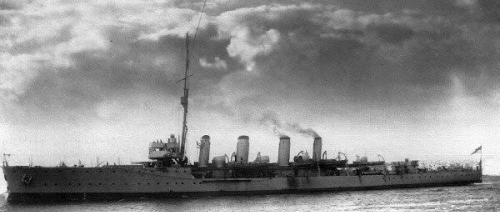

Adventure 1905
| Name | No | Yard No | Builder | Laid down | Launched | Comp | Fate |
| Adventure (ex-Eddystone) | D10, P64, P01 | 741 | Armstrong, Elswick | 7.1.1904 | 8.9.1904 | 10.1905 | sold 3.1920 |
| Attentive | P03, P06 | 748 | Armstrong, Elswick | 8.1.1904 | 24.11.1904 | 10.1905 | sold 4.1920 |
|
Displacement normal, t |
2640 |
|
Displacement full, t |
|
|
Length, m |
114.0 pp 120.4 oa |
|
Breadth, m |
11.7 |
|
Draught, m |
3.73 |
|
No of shafts |
2 |
|
Machinery |
2 3-cyl VTE, 12 Yarrow boilers |
|
Power, h. p. |
16000 |
|
Max speed, kts |
25 |
|
Fuel, t |
coal 450 |
|
Endurance, nm(kts) |
3000(10) |
| Armour, mm | deck: 51 - 19, CT: 76 |
|
Armament |
10 x 1 - 76/50 12pdr 18cwt QF Mk I, 8 x 1 - 47/40 3pdr Hotchkiss Mk I, 2 - 450 TT (beam aw) |
|
Complement |
268 |
Project history: Eight cruisers were intended to work in company with destroyers as scouts, to lead torpedo attacks and to back up their flotillas when attacked by enemy destroyers. The Admiralty provided a broad specification for the ships and left the detailed design to the builders, a common practice when ordering torpedo craft but unusual with cruisers. The Admiralty requirement was for a 25kt ship, with a 38mm protective deck or equivalent side armour, shallow draught for operating in inshore waters, and an armament of 10 76mm, 8 47mm and 2 TT. They were ordered in four pairs which, as might be expected, resulted in four sub-classes that varied substantially in form, machinery and structure. Only one builder, Fairfield, followed traditional small cruiser style in providing a poop as well as a forecastle, but all abandoned the bulwarks amidships which had become a common feature of Victorian cruisers. The Armstrong pair differed from all the others in having four instead of three funnels and a clipper bow, while the Vickers ships had shorter funnels than the other ships. The Fairfield pair employed side armour abreast the machinery compartments with a protective deck at the ends, while Cammell provided side armour abreast the engine rooms only with a protective deck over the remainder of the ship, an expedient intended to protect the engine cylinders. The remaining ships were fitted in the usual manner with a full length protective deck. The 12pdr QF guns were mounted 3 abreast on the forecastle and aft and two on each side amidships, but this armament was heavily criticised for being too light.
Ship protection: The protective deck was 25mm on the flat and 51mm on the slope amidships, reducing to 19mm flat and 25mm slope at the ends. Also engine glacis had 51mm protection.
Modernizations: 1905-1906, both: - 8 x 1 - 47/40; + 2 x 1 - 76/50 12pdr 18cwt QF Mk I, 6 x 1 - 57/40 6pdr Hotchkiss Mk I
8/1912, both: - 12 x 1 - 76/50, 6 x 1 - 57/40; + 9 x 1 - 102/40 QF Mk IV
by 1918, Attentive (as in Jane`s 1919): - 3 x 1 - 102/40, 2 - 450 TT; + 2 x 1 - 152/45 BL Mk VII, 1 x 1 - 76/45 20cwt QF Mk I, 1 x 1 - 57/40 6pdr Hotchkiss Mk I, 2 x 1 - 40/39 2pdr QF Mk II, 2 x 1 - 356 TT
Naval service: Adventure was damaged in January 1920 by ramming by trawler. Attentive 6.8.1907 collided with destroyer Quail off Portland, 27.4.1908 she double collided with destroyers Gala (lost) and Ribble.
Many thanks to Wolfgang Stöhr for additional information on this page.

Attentive
© Ivan Gogin, 2008-09